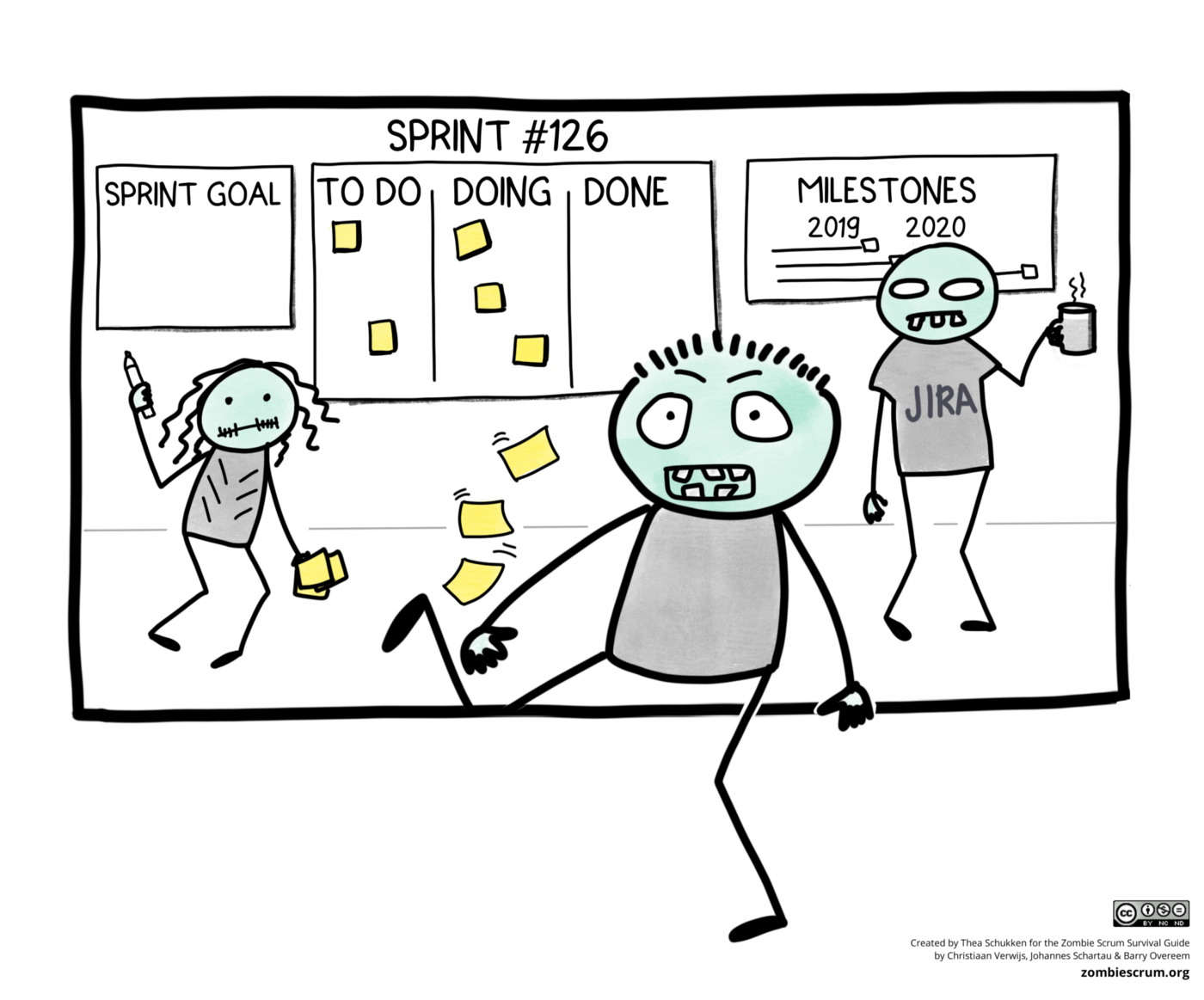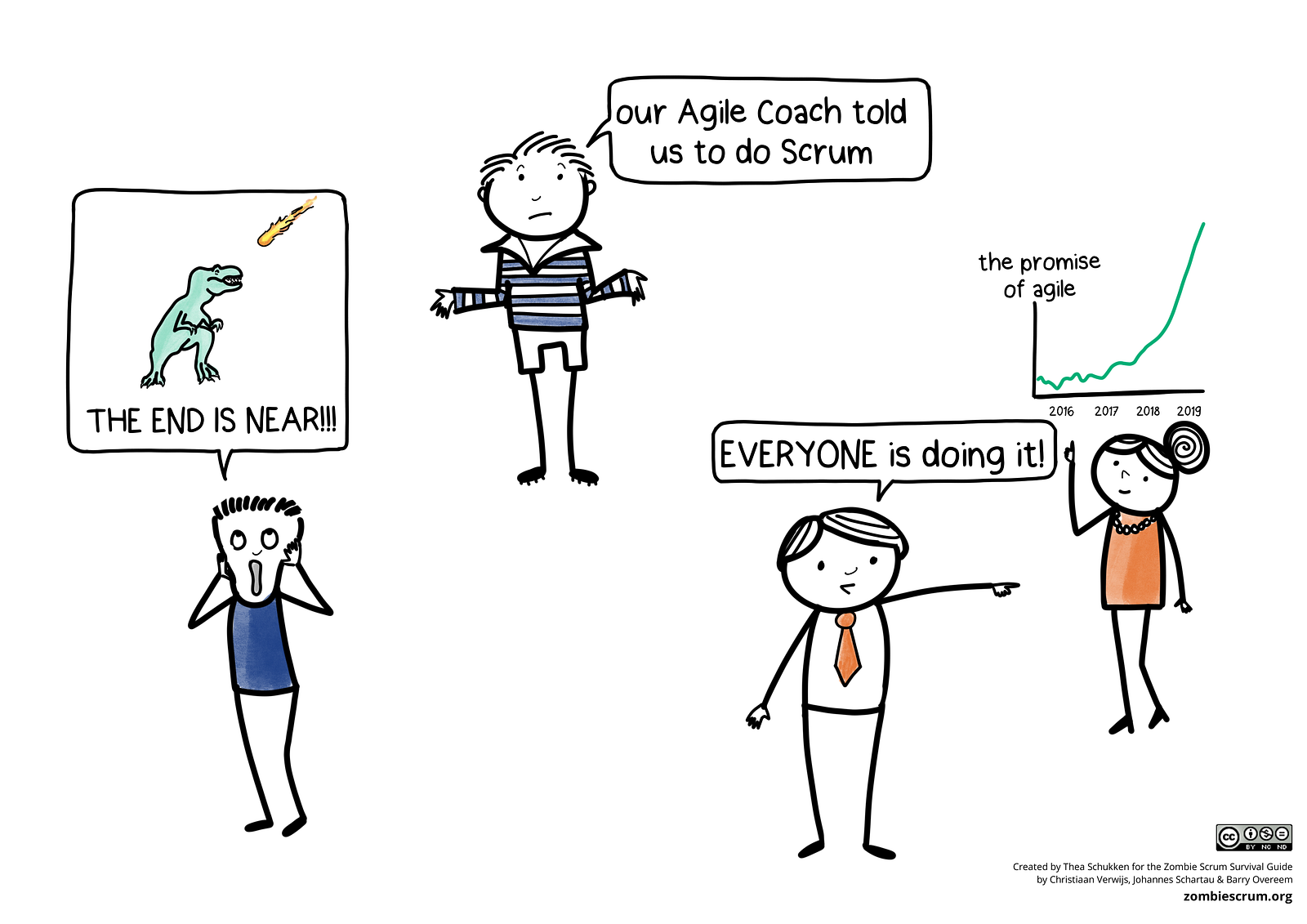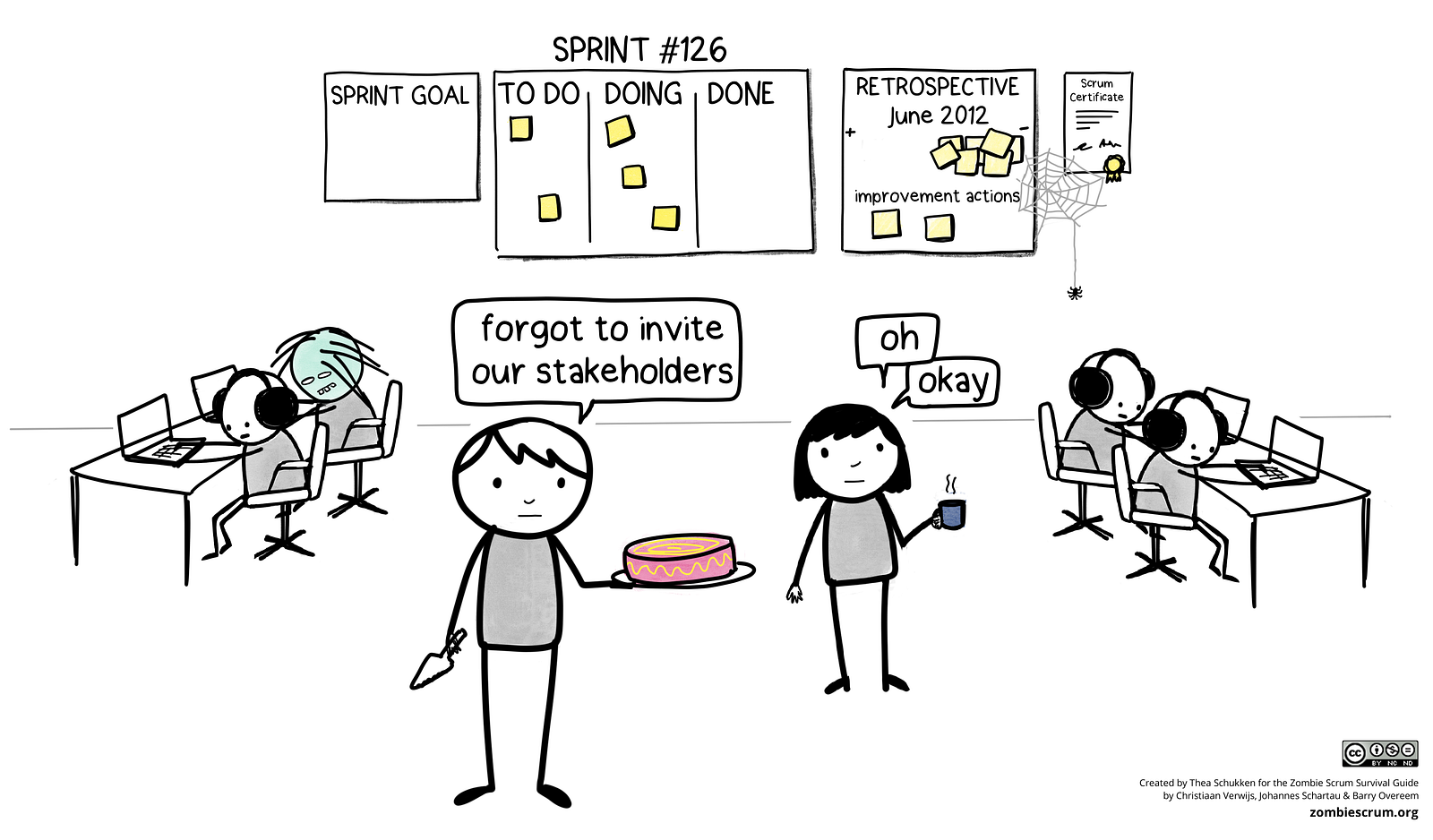Scrum
Gergő Pintér, PhD
gergo.pinter@uni-corvinus.hu
this presentation is based on The Scrum Guide (2020)
by Ken
Schwaber and Jeff Sutherland [1]
available from scrumguides.org under CC BY-SA 4.0
or download directly from here
what is scrum?
Scrum is a lightweight framework that helps people, teams and organizations generate value through adaptive solutions for complex problems.
Scrum employs an iterative, incremental approach to optimize predictability and to control risk. Scrum engages groups of people who collectively have all the skills and expertise to do the work and share or acquire such skills as needed.
scrum in a nutshell
scrum requires a scrum master to foster an environment where:
- a product owner orders the work for a complex problem into a product backlog
- the scrum team turns a selection of the work into an increment of value during a sprint
- the scrum team and its stakeholders inspect the results and adjust for the next sprint
- repeat
scrum team
- the scrum team consists of
- one scrum master,
- one product owner,
- and developers
- there are no sub-teams or hierarchies
size of a scrum team
- small enough to remain nimble and large enough to complete work in a
sprint
- typically 10 or fewer people
- 3 to 9 people is optimal
- smaller teams communicate better and are more productive
- if a team becomes too large, they should consider reorganizing into
multiple cohesive scrum teams
- each focused on the same product
- therefore, they should share the same product goal, product backlog, and product owner
communication within a team
communication within a team
team size
scrum teams are cross-functional
- the members have all the skills necessary to create value each sprint
- they are also self-managing, meaning they internally decide who does what, when, and how
developers
- committed to creating any aspect of a usable increment each sprint
- the specific skills needed by the developers are often broad and will vary with the domain of work
- developers are accountable for
- creating a plan for the sprint, the sprint backlog,
- instilling quality by adhering to a definition of done,
- adapting their plan each day toward the sprint goal, and
- holding each other accountable as professionals
definition of done
- checklist
- defines steps to complete the sprint goal
- helps to track the progress of the sprint
- the sprint is done, if every element of the checklist is done
product owner
- accountable for maximizing the value of the product resulting from the work of the scrum team
- also accountable for effective product backlog management, which
includes:
- developing and explicitly communicating the product goal,
- creating and clearly communicating product backlog items,
- ordering product backlog items, and
- ensuring that the product backlog is transparent, visible and understood
The product owner may do the above work or may delegate the responsibility to others. Regardless, the product owner remains accountable.
scrum master
- accountable for
- establishing scrum as defined in the Scrum Guide
- by helping everyone understand the theory and practice, both within the scrum team and the organization
- for the scrum team’s effectiveness
- by enabling the scrum team to improve its practices, within the scrum framework
- establishing scrum as defined in the Scrum Guide
scrum master serves the scrum team
- coaching the team members in self-management and cross-functionality,
- helping the scrum team focus on creating high-value increments that meet the definition of done,
- causing the removal of impediments to the scrum team’s progress, and
- ensuring that all scrum events take place and are positive, productive, and kept within the timebox
scrum master serves the product owner
- helping find techniques for effective product goal definition and product backlog management,
- helping the scrum team understand the need for clear and concise product backlog items,
- helping establish empirical product planning for a complex environment, and
- facilitating stakeholder collaboration as requested or needed
scrum master serves the organization
- leading, training, and coaching the organization in its scrum adoption,
- planning and advising scrum implementations within the organization,
- helping employees and stakeholders understand and enact an empirical approach for complex work, and
- removing barriers between stakeholders and scrum teams
scrum events
- sprint
- sprint planning
- daily scrum
- sprint review
- sprint retrospective
sprint
Sprints are the heartbeat of Scrum, where ideas are turned into value.
- fixed length events (maximum one month) to create consistency
- a new sprint starts immediately after the end of the previous
during the sprint
- no changes are made that would endanger the sprint goal,
- quality does not decrease,
- the Product Backlog is refined as needed, and
- scope may be clarified and renegotiated with the product owner as more is learned
about sprints
- in the case of a long sprint
- the sprint goal may become invalid
- complexity may rise, and
- risk may increase
- each sprint may be considered a short project
- a sprint could be cancelled if the sprint goal becomes obsolete
- only the product owner has the authority to cancel the sprint
tracking progress - burndown chart
burndown chart is a graphical representation of work left to do versus time [2]
- two week sprint
- 26 tasks
- ideal work line (green)
- not realistic
- actual work line (red)
- finished tasks per day (blue bars)
tracking progress - cumulative flow diagram
tracking progress - cumulative flow diagram
widening of bands: bottleneck;
more tasks enter that phase than
leaving
narrowing of bands: throughput is higher than the number of tasks entering the workflow
figures are based on [3]
sprint planning
- sprint planning initiates the sprint
- collaborative work of the entire scrum team
- the product owner ensures that attendees are prepared to discuss the most important product backlog items and how they map to the product goal
- the scrum team may invite other people to provide advice
- sprint planning lasts a maximum of eight hours for a one-month
sprint
- for shorter sprints the event is shorter
topics of sprint planning - why is this sprint valuable?
- the product owner proposes how the product could increase its value and utility in the current sprint
- the whole scrum team then collaborates to define a sprint goal that communicates why the sprint is valuable to stakeholders
- the sprint goal must be finalized prior to the end of sprint planning
topics of sprint planning - what can be done this sprint?
- in agreement with the product owner, the developers select items from the product backlog to include in the current sprint agenda
- the scrum team may refine these items during this process
- not easy to select how much can be completed within a sprint
- the more the developers know about
- their past performance (e.g., burndown charts),
- their upcoming capacity (e.g., vacation, holidays), and
- the definition of done,
- the more confident they will be in their sprint forecasts
topics of sprint planning - wow will the chosen work get done?
- for each selected item, the developers plan the work necessary to create an increment that meets the DoD
- often done by decomposing product backlog items into smaller work
items of one day or less
- tasks completable in 1-4 hours may be preferred
- how this is done is up to the developers
- no one else tells them how to turn product backlog items into increments
sprint planning - summary
- select the sprint goal
- select product backlog items to achieve the sprint goal
- plan how they shall be implemented
The sprint goal, the product backlog items selected for the sprint, plus the plan for delivering them are together referred to as the sprint backlog.
daily scrum
- the purpose of the daily scrum is to inspect progress toward the sprint goal and adapt the sprint backlog as necessary, and discussing the upcoming planned work
- the daily scrum is a 15-minute event for the developers
- to reduce complexity, it is held at the same time and place every working day of the sprint
- if the product owner or scrum master are actively working on items in the sprint backlog, they participate as developers
daily stand-up
- the developers can select whatever structure and techniques they want
- also called daily stand-up, because they stand up from the desks and
go to a meeting place
- as it is limited to 15 minute, no need to book a meeting room;
- daily scrums improve communications, identify impediments, promote quick decision-making, and consequently eliminate the need for other meetings
three questions
each team member participating the daily scrum answers three questions:
- what was done since the last daily scrum?
- what will be done till the next daily scrum?
- are there any impediments that prevent the work?
keep daily stand-up short
- answer the three question only
- do not start finding solutions for the problems
- the daily scrum is not the only time developers are allowed to discuss the sprint backlog
- they can meet throughout the day for more detailed discussions

sprint review
- the scrum team presents the their work to key stakeholders
- and the progress toward the product goal is discussed
- the attendees collaborate on
what to do next - the product backlog may also be adjusted to meet new opportunities

sprint review II
- should not limiting it to a presentation, the working product should be demonstrated and discussed
- timeboxed to a maximum of four hours for a one-month sprint
- for shorter sprints, the event is usually shorter

sprint retrospective
- he purpose of the sprint retrospective is to increase quality and effectiveness
- the sprint retrospective concludes the sprint
- it is timeboxed to a maximum of three hours for a one-month sprint
- for shorter sprints, the event is usually shorter
sprint retrospective II
- the scrum team inspects how the last sprint went with regards to
- individuals,
- interactions,
- processes,
- tools, and
- their definition of done
- the scrum team discusses
- what went well during the sprint,
- what problems it encountered, and
- how those problems were (or were not) solved
retrospective starfish
- divide the whiteboard to 5 parts
- every team member adds sticky notes to the respective parts
scrum artifacts
- scrum artifacts represent work or value
- they are designed to maximize transparency of information
- the product backlog
- progress towards the product goal
- sprint backlog
- progress within the sprint goal
- definition of done
- state of the product increment
product backlog
- ordered list of what is needed to improve the product
- describes a future state of the product
- product owner is responsible for its content and prioritization
product backlog refinement
product backlog refinement is the act of breaking down and further defining product backlog items into smaller more precise items.
sprint backlog
- composed of the sprint goal (why),
- the set of product backlog items selected for the sprint (what),
- a plan for delivering the increment (how)
- by and for the developers
- visible, real-time snapshot of the sprint progress
sprint backlog
- if the work may turn out different than expected
- because software development is like gardening
- then the developers negotiate the scope with the product owner without affecting the sprint goal
increment
- an increment is a step toward the product goal
- each increment is additive to all prior increments
- and verified, ensuring that all increments work together
- in order to provide value, the increment must be usable
- multiple increments may be created within a sprint
- work cannot be considered part of an increment unless it meets the definition of done
scrum of scrums
- each scrum team delegates an “ambassador” to attend the scrum of scrums meetings
- meetings are not as frequent as daily scrum
- synchronizes state of the scrum teams
- agenda: same 3 questions but regarding a team
- plus, issues that (can) affect the other scrum teams
zombie scrum
Zombie Scrum is Scrum, but without the beating heart of working software.

mindset
- zombie scrum
-
although every sprint can result in a new version, only the final version delivers real value
- healthy scrum
-
every sprint delivers value

working software
- zombie scrum
-
working software is nice to have
- healthy scrum
-
working software is essential
what is work
- zombie scrum
-
writing code is work, everything else is a waste of time
- healthy scrum
-
writing code is important part of work, but building good software requires frequent interaction with the team, stakeholders, and peers

treatments
- Zombie Scrum teams often benefit from a shortened Sprint length. Instead of three to four-week iterations decrease the length to two weeks or even just one.
- Focus the Sprint Planning on answering the question of what type of impact the team would like to achieve within the upcoming Sprint.
- Start the Daily Scrum by reviewing the Sprint Goal and asking what achievements the team has made towards reaching that goal.
- Use the roadmap to provide context for the insights from the Review meeting. And for heaven’s sake, invite some real customers or stakeholders!
- Use the Retrospective not to drag out the same old problems but to dream big. A transformational approach might be better suited than an incremental one.